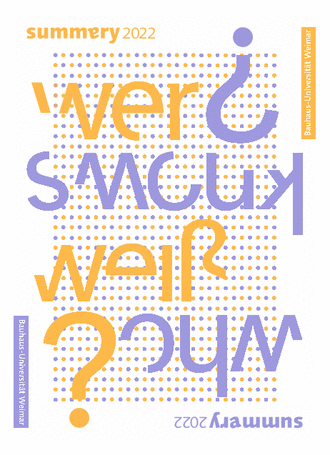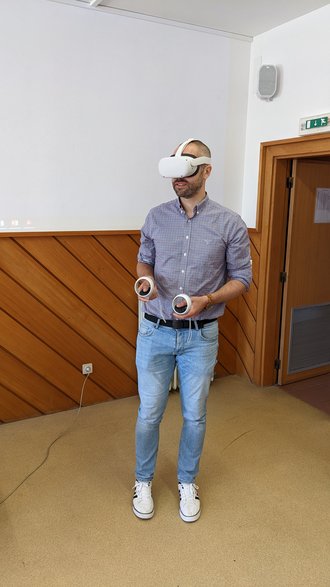Projects at summaery2022: Discussing virtual lab experiments for a better understanding of teaching materials with Mahsa Mirboland
This year, the Bauhaus-Universität Weimar’s annual show has the intentionally ambiguous bilingual title of »Wer weiß? | Who knows?« and explores how, where and by whom knowledge is produced. Among the projects due to be showcased is »PARFORCE«, a partnership for virtual laboratories in civil engineering within which students from the Faculty of Civil Engineering have been working on the question of how virtual and remote-controlled experiments can be integrated into university practice. We spoke to course tutor Mahsa Mirboland from the Professorship for Complex Structures about the project and the work with the students.
What is special about the project, the topic or the methods?
One important aspect of the project is the use of modern learning tools to improve accessibility and interoperability, i.e. the ability of different systems to work together as seamlessly as possible. This means that students participating in our pilot course will have the opportunity to test experiments at different universities and have full access to our partner institutions all across Europe.
The special nature of the experiments should be emphasised: the facilities include a shaking table, combustion chamber and large-scale wind tunnel. These aren’t all available as standard at every partner university and are also interesting for other universities that do not have such experimental facilities.
Overall, we are aiming for an immersive interactive open access platform. So our goal is to make virtual labs available to everyone. We’re very selective when it comes to choosing the right tools so that students from all over Europe or even around the globe can access virtual experiments and learn for free with the least possible device dependency.
With what level of knowledge did you start the project and how did it develop?
Well, our knowledge of virtual and mixed reality applications was more than minimal. We were aware of implementations in different disciplines around the world and were able to obtain prior knowledge and feedback from different colleagues thanks to previous joint projects and good communication within our university. Our thanks to Professor Rodehorst, Professor Koch, Dr Söbke and Florian Wehking, who acted as mentors to me during preparation of the content for »PARFORCE«. Today, we have learned from past experiences and are now working to prepare the virtual tours for our pilot course, which will start in winter semester 2022. We’re still halfway through the project and are looking forward to the pilot course and the feedback from students. It’s all trial and error, of course. But without feedback, it wouldn’t be perfect yet, would it?
What hurdles did you have to overcome during the learning process?
One key challenge was identifying learning objectives and the corresponding didactic tools. As we’re integrating different experiments into our pilot course (e.g. fire resistance tests, wind tunnel tests, seismic tests), we need to ensure that the framework for all types of experiments is consistent and comprehensive. This is also important for the evaluation when we can conduct a survey at the end of the project and assess how successful and effective our virtual labs were. Another challenge is to find suitable tools for our purpose: which software/hardware is easy to use, affordable to acquire and accessible to all? So we had to ensure that our framework was not yet another luxury, but rather a feasible alternative.
What knowledge would you like to pass on to others?
Since launching the project one year ago, we’ve tested the potential of virtual and mixed reality tools and can confirm that they work. So far, we’ve produced interactive VR tours that can be integrated into learning platforms such as Moodle, uploaded to a freely accessible website or even run on standalone devices. The integrated e-learning framework monitors students’ performance from the moment they enter the »virtual lab« until they complete the final assignment. Students can currently only interact with pre-recorded data and watch VR clips to learn experiment procedures and answer quiz questions. We want to integrate live experiments into the same format in future. Those interested in learning more should take one of our VR tours during the summaery.
Five partner universities based in four countries are involved in the project »PARFORCE – Partnership for virtual laboratories in civil engineering«, namely the University of Aveiro, Ruhr University Bochum, Ss. Cyril and Methodius University in Skopje, Josip Juraj Strossmayer University of Osijek, and the Bauhaus-Universität Weimar. The project is funded by the EU through the ERASMUS+ programme and will run from 1 June 2021 to 31 May 2023.
The project will be presented on 15 July during the summaery as part of the »SCIENCE MILE Q3« open day on Coudraystraße. The Professorship for Complex Structures within the Faculty of Civil Engineering is responsible for »PARFORCE« at the Bauhaus-Universität Weimar.
Exhibition venue:
Immersive virtual reality experiments, Friday 15 July 2022, 3–6 pm
MFPA Weimar/testing facility (VTE), Ground Floor (Hall)
Coudraystraße 4
99423 Weimar
Student poster session
MFPA Weimar/testing facility (VTE), Foyer
Coudraystraße 4
99423 Weimar
More information on the project: www.uni-weimar.de/de/bauingenieurwesen/professuren/komplexe-tragwerke/forschung/parforce and www.uni-weimar.de/de/universitaet/aktuell/jaehrliche-veranstaltungen/jaehrliche-veranstaltungen-2022/summaery/science-mile-q3


